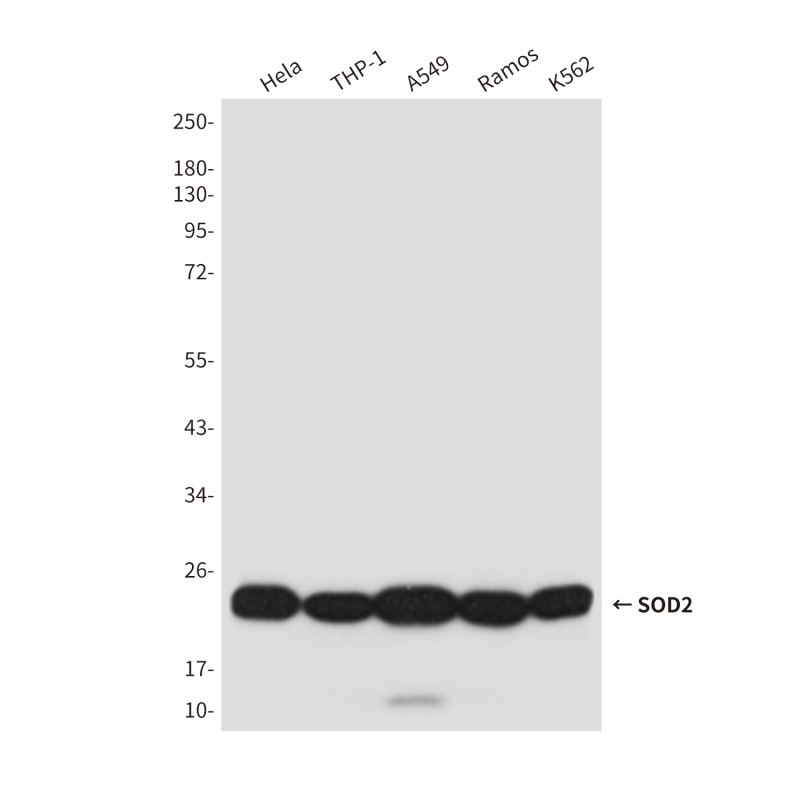
| WB | 咨询技术 | Human,Mouse,Rat |
| IF | 咨询技术 | Human,Mouse,Rat |
| IHC | 咨询技术 | Human,Mouse,Rat |
| ICC | 技术咨询 | Human,Mouse,Rat |
| FCM | 咨询技术 | Human,Mouse,Rat |
| Elisa | 咨询技术 | Human,Mouse,Rat |
| Aliases | IPOB; IPO-B; MNSOD; MVCD6; Mn-SOD; SOD2 |
| Entrez GeneID | 6648 |
| clone | 7C5 |
| WB Predicted band size | Calculated MW: 25 kDa; Observed MW: 22 kDa |
| Host/Isotype | Mouse IgG2b |
| Antibody Type | Primary antibody |
| Storage | Store at 4°C short term. Aliquot and store at -20°C long term. Avoid freeze/thaw cycles. |
| Species Reactivity | Human |
| Immunogen | Synthetic peptide corresponding to human SOD2 protein |
| Formulation | Purified antibody in PBS with 0.05% sodium azide,0.5%BSA and 50% glycerol. |
+ +
以下是3篇关于SOD2(超氧化物歧化酶2)抗体的参考文献及其简要摘要:
1. **"Mitochondrial SOD2 regulates epithelial-mesenchymal transition and cell populations defined by differential CD44 expression"**
- **作者**: Kim J, et al.
- **摘要**: 该研究利用SOD2抗体检测线粒体SOD2在癌细胞中的表达,发现其通过调节氧化应激水平影响上皮-间质转化(EMT),并与CD44阳性肿瘤干细胞群体的存活相关。
2. **"Antibody-based profiling of mitochondrial superoxide dismutase 2 in Alzheimer's disease"**
- **作者**: Smith MA, et al.
- **摘要**: 通过SOD2特异性抗体进行免疫组化分析,发现阿尔茨海默病患者脑组织中SOD2表达显著降低,提示线粒体氧化损伤可能参与疾病进展。
3. **"Validation of a commercial SOD2 antibody for use in western blotting and immunohistochemistry"**
- **作者**: Johnson RM, et al.
- **摘要**: 验证了一种商业化SOD2抗体的特异性,证明其在Western blot和免疫组化中可准确识别人类和小鼠组织中的SOD2蛋白,为氧化应激相关研究提供可靠工具。
4. **"SOD2 deficiency promotes aging-related lung fibrosis via mtDNA release"**
- **作者**: Hecker L, et al.
- **摘要**: 使用SOD2敲除小鼠模型及抗体检测,发现SOD2缺失导致线粒体DNA释放,激活炎症通路并加速肺纤维化进程,提示其作为衰老相关疾病的治疗靶点。
这些文献涵盖了SOD2抗体在疾病机制、抗体验证及分子调控研究中的应用。
SOD2 (superoxide dismutase 2) antibodies are essential tools for studying the mitochondrial isoform of superoxide dismutase, a critical antioxidant enzyme that neutralizes superoxide radicals generated during oxidative phosphorylation. SOD2 converts harmful superoxide anions into hydrogen peroxide and oxygen, playing a central role in cellular defense against oxidative stress. Dysregulation of SOD2 expression or activity is linked to numerous diseases, including cancer, neurodegenerative disorders, diabetes, and aging-related conditions, making it a key focus in biomedical research.
These antibodies are widely used to detect SOD2 protein levels, localization, and expression patterns in tissues or cultured cells through techniques like Western blotting, immunohistochemistry (IHC), and immunofluorescence (IF). Researchers rely on SOD2 antibodies to investigate mitochondrial function, redox homeostasis, and disease mechanisms. Both monoclonal and polyclonal variants exist, with monoclonal antibodies offering higher specificity and polyclonal antibodies providing broader epitope recognition. Validation via knockout cell lines or siRNA-mediated SOD2 silencing is crucial to confirm antibody specificity, as cross-reactivity with other SOD isoforms (e.g., cytosolic SOD1) may occur.
Commercial SOD2 antibodies are typically raised against conserved human or mouse epitopes, enabling cross-species reactivity in many cases. Their applications span basic research, clinical diagnostics, and therapeutic development, particularly in studies exploring oxidative damage and mitochondrial dysfunction. Proper experimental controls, including tissue-specific expression validation and stress-induced SOD2 upregulation assays, are recommended to ensure reliable results.
×